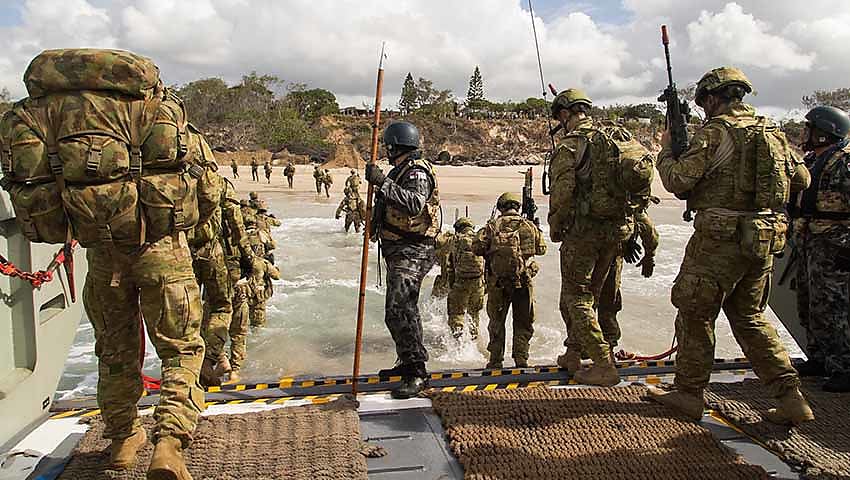The Australian Army is undergoing a period of unprecedented modernisation and expansion – however, as the Army is required to respond to an increasing number of potential contingencies in defence of the national interest, is the Army large enough to reliably execute the mission in a radically evolving geo-political and strategic order?
Modern warfare has rapidly evolved over the last three decades, from high-tempo, manoeuvre-based operations that leveraged the combined capabilities of air, sea, land and space forces to direct troops, equipment and firepower around the battlefield during the first Gulf War, to low intensity, humanitarian and peacekeeping operations in southern Europe and the south Pacific, and the eventual rise of asymmetrical, guerilla conflicts in the mountains of Afghanistan and streets of Iraq.
However, the growing conventional and hybrid capabilities of peer and near-peer competitors – namely Russia and China – combined with the growing modernisation, capability enhancements and reorganisation of force structures in the Army's of nations including India, Indonesia, Vietnam and Thailand all contribute to the changing nature of contemporary land warfare.
Additionally, Australia's strategic reorientation to focus on the Indo-Pacific region makes a great deal of sense, particularly given the positioning of key regional economic and strategic partners across what has been referred to as the 'Arc of Instability' characterised by narrow archipelagos, swathes of jungle and advanced anti-access, area denial (A2/AD) systems like those introduced in the South China Sea.
Despite the introduction of Plan Beersheba in 2011, the introduction of 'Accelerated Warfare' and the shift towards developing a truly 'combined arms' force capable of leveraging Australia's traditional advantages in high-tech platforms, world-class infantry and 'espirit de corps' serves as the nation's first attempt to modernise and recapitalise the Army to face the fluid tactical and strategic challenges of the 21st century battlefield.
The question remains, given the geographic area of responsibility Australia will become increasingly responsible for and dependent on, is the Australian Army and the existing recapitalisation and modernisation programs currently underway enough for Australia to maintain its qualitative and quantitative lead over regional peers?
Key piece of the jigsaw puzzle – Army's role in power projection
The introduction of 'Accelerated Warfare' builds on the reorganisation and modernisation efforts outlined in Plan Beersheba, which sought to establish the Australian Army as an integrated, combined arms force, which Major General Gus McLachlan, retired Commander Forces Command, described: "In Plan Beersheba we have the spine, the backbone of our 21st century, combined arms force, but it isn't the future. That is where Accelerated Warfare comes into play, it aims to make Army an adaptable and capable force."
This focus on the capability, particularly the expeditionary capability of Army, is supported by Dr Malcolm Davis of ASPI, who told Defence Connect, "I feel that the ADF needs responsive and effective power projection, air and naval, and boosting Army's strategic mobility and amphibious capability.
"It is better to build our force structure to project power forward, deep into maritime south-east Asia and beyond, and also have forward military presence in the Indian Ocean and the south Pacific."
Recognising this, what does the future Army look like? How large is it, how is it organised and what capabilities does it need to maintain its qualitative edge over potential adversaries?
Force structure concepts and an increase in size
Defence Connect has introduced a number of force structure concepts, recognising the need for both amphibious expeditionary forces and conventional 'heavy' ground forces, namely concepts such as:
Marine Expeditionary Units (MEU) and Air-Ground Task Forces (MAGTF): The US Marine Corps and its globally deployed MEUs and MAGTFs provide the US with an unrivalled, rapid response to contingencies ranging from humanitarian disaster relief and counter-insurgency to sea control and high-intensity power projection combat operations against a peer competitor.
Both the MEU and MAGTF concepts utilise US Navy LHDs and landing platform docks (LPD) supported by surface combatants to rapidly deploy integrated, 'combined arms' forces, including amphibious landing, infantry, artillery, armour, combat engineers, both rotary and fixed-wing air support (both lift and attack), logistics, medical and supply chain services.
Brigade Combat Team (BCT): Complementing the capabilities of Australia's amphibious force is the introduction of a larger, heavier Army organisation akin to the US Army BCT - which can be highly specialised and consist of one combat arms branch manoeuvre brigade, support and fire units. They are typically made up of about 4,500 soldiers, with specialised infantry, mechanised infantry and light armoured reconnaissance, armoured units, divisional artillery, air, medical, logistics and command support.
The specialised focus of BCTs provides a diverse, QRF capable of meeting any number of contingencies, without limiting the overall combat strength of the Army, by deploying a proportional, tailored, brigade size 'combined arms' force to global hotspots, within 96 hours, as opposed to a division-sized force at 120 hours.
BCTs serve as the basis of the US forward-deployed conventional, ground-based, power projection and deterrence forces in continental Europe, with a series of modernisation programs to enhance the combat lethality and deployability of key platforms to combat continued Russian aggression in eastern Europe.
As Australia's role in Indo-Pacific Asia and the strategic balance of power continues to evolve, the Australian Army will be called upon to fulfil a range of roles beyond those it has conducted over the past 50 years. Power projection and the application of 'hard power' in both a high and low intensity capacity will dramatically reshape the Australian Army despite an unprecedented level of investment.
Get involved with the discussion and let us know your thoughts on the future of Australia's ground-based power projection forces and the broader direction of the Australian Army's modernisation and restructuring, as outlined in the 'Accelerated Warfare' doctrine, in the comments section below, or get in touch with








